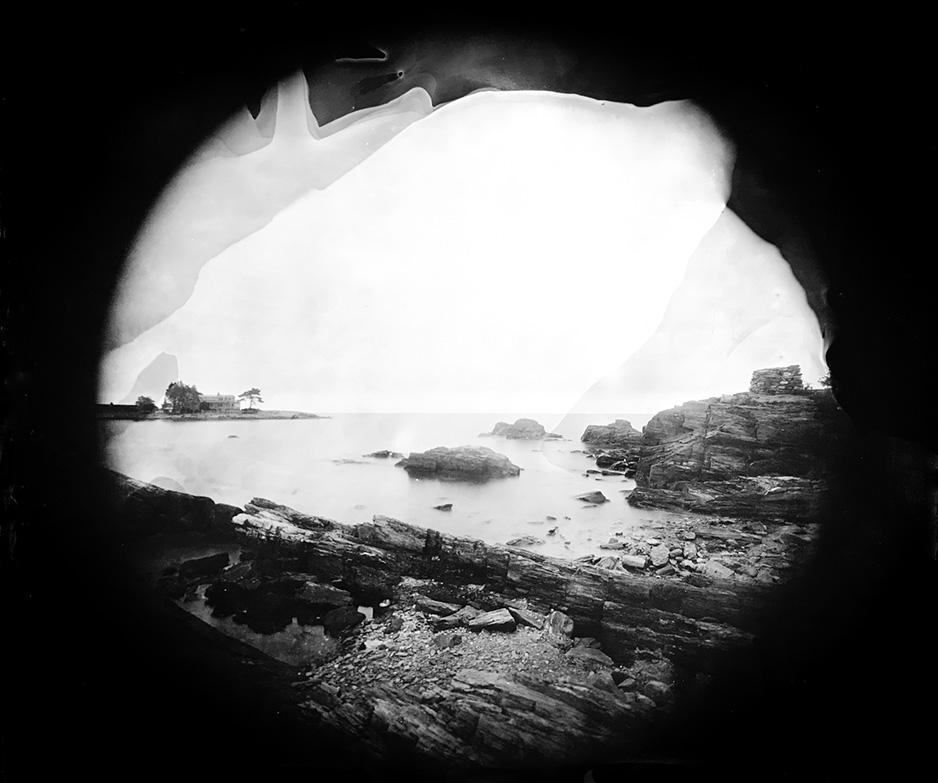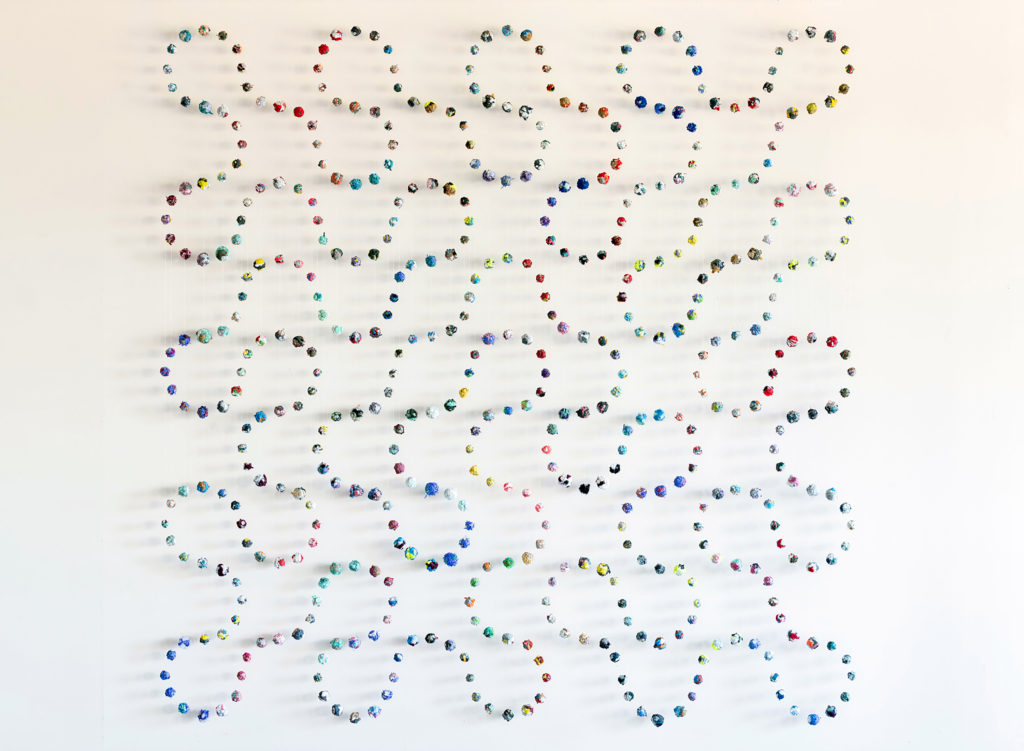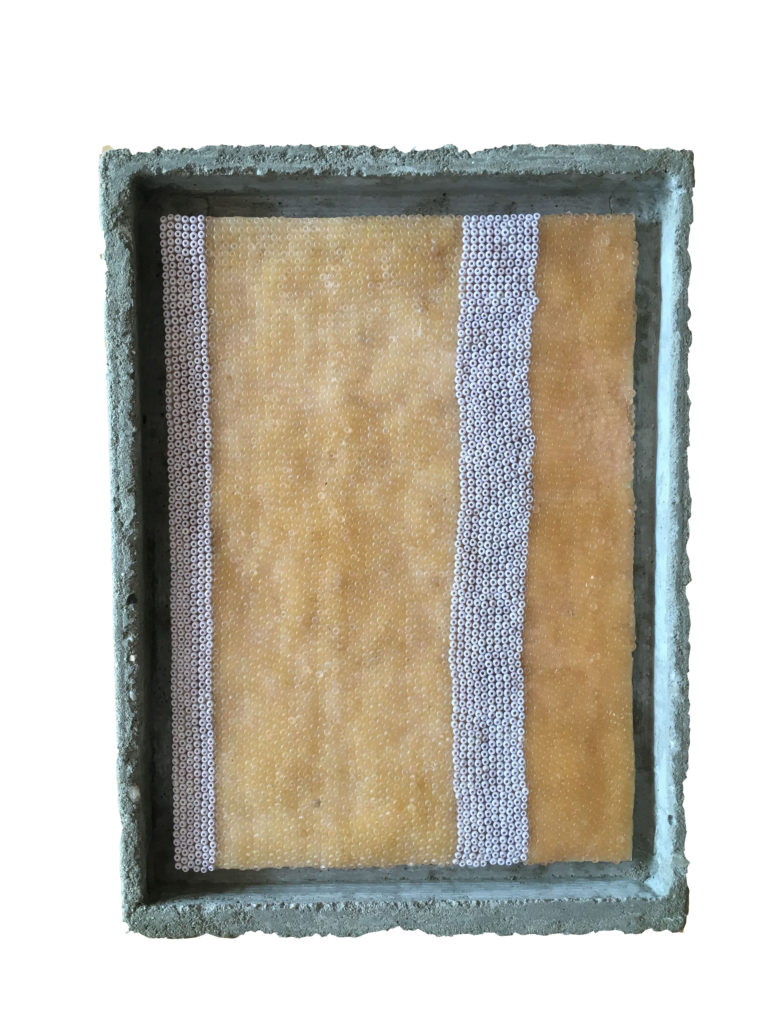Shifting Sequences: 2022 Juried Artist Exhibition
The 18 up and coming Maine artists to watch this year.

Shifting Sequences: 2022 Juried Artist Exhibition
The 18 up-and-coming Maine artists to watch this year.
Issue: September 2022
Meet the Judges

HILARY IRONS, Maine magazine’s arts columnist, is a painter and curator living and working in Portland. She is the gallery and exhibitions director at the University of New England and a cofounder of Able Baker Contemporary in Portland’s Arts District as well as an educator teaching at the Maine College of Art and Design and Bowdoin College.

ANJULI LEBOWITZ came from the National Gallery of Art in D.C. to become the inaugural Judy Glickman Lauder Associate Curator of Photography at the Portland Museum of Art. As a Jane and Morgan Whitney Fellow at the Metropolitan Museum of Art she curated Faith and Photography: Auguste Salzmann in the Holy Land. Her interests include photographic albums, feminist and Black counter narratives, and cross-cultural artistic networks.

TIMOTHY PETERSON has served as executive director and chief curator for the Center for Maine Contemporary Art since January 2021. He is also an active advocate for artists, contemporary art, audience engagement, equity, access, and transparency. He has curated over 150 exhibitions to-date with artists including solo exhibitions by Ryan Adams, Nicola López, Reggie Burrows Hodges, Nari Ward, Ghada Amer, Chris Doyle, Paul Mpagi Sepuya, Njikdeka Akunyili Crosby, Ghada Amer, and Kehinde Wiley.

SAMANTHA BUTLER is an arts organizer and multidisciplinary artist based out of Biddeford. In 2021 she joined TEMPOart as the organization’s manager and has led the program through its 2022 public art commission. This September, she will step into the role of program manager at Surf Point Foundation, a nationally acclaimed artist residency in York. Butler has a rich history of developing engaging, artist-centric programming, especially supporting emerging artists.
Amy Brnger
As long as I have painted, I have been influenced by seasons as well as my emotional state while working. My approach to a bouquet, a landscape, or an interior will be different depending upon weather, the quality of light, whether I am tired and crabby or energized and happy. All are reflected in the final image. The way I push paint around a panel, feel the paint on my palette knife and brush, is dependent upon my feeling state and the current season. I try hard to keep the surprises that make their way onto a panel and stop the painting a few steps before it is finished. Sometimes the image might look awkward and slightly underdone, but if it feels genuine and somehow a reflection of how I see the world in that particular moment, then I want to keep it. When I keep working past that point, the likelihood of scraping the response away, or having an overworked image, is great. Throughout the pandemic I have often felt worried, sometimes sad, and often anxious, yet I continue to see beauty in our world. As you look at my flowers and interiors in January, birds and blooms in May, reflections of my studio and hot bright roofs in August, and the somber light of fall landscapes and end-of-season blooms, I hope you can catch a glimpse of the world as I see it.

Oil on panel, 24″ x 30″ | Van Ward Gallery, Ogunquit | vanwardgallery.me
Brian Smith
I am a sculptor interested in philosophies of queer ecology and humankind’s relation to nature. My content translates a yearning to reconnect with the natural world and make sense of it through the language of reflection, desire, and awe. My work intrigues yet confounds the viewer, evoking ripples of curiosity that invite them to consider their own relation to the natural world. I interpret nature through the queer lens, meaning “strange, odd, different,” while also utilizing tropes of queerness like campiness, sexuality, subversion, and counterculture. I work in a variety of materials, all centering sculpture as the manifestation of the themes I explore in which I offer a queer approach to a conjured, more collaborative future.

Welded steel, foam, plaster, pigment, acrylic forms, fabric, oil pigment, and wax, 111″ x 72″ x 72″
Eugene Cole
The working title for this project is Wetplate Seascapes. All the images are silver gelatin contact prints made from wet plate collodion negatives. I work with traditional and historical photographic processes ranging from 35mm film to mammoth 20- by 24-inch glass plate negatives. The bulk of my subject matter explores the juxtaposition and interaction of the land and sea.

Silver gelatin print, 20″ x 24″
Edward Duffy
I have always been compelled to draw. I would draw on my desk at school, on friends’ clothes, in the dirt, and everywhere else I was and wasn’t supposed to. I also love to look and listen to as much as I can, to try and make sense of things and to find importance. I like my work to have a childlike, surreal style that simplifies and amplifies the subject. Through my work I explore my own experience with the world around me, and I hope to make art more accessible and mainstream through digital ownership and universal display.

Digital, 5000 x 4000
Elyse Grams
I mine the complicated and intertwined histories of ceramics and womanhood and their symbolic associations with refinement and “good taste.” My sloppy, anthropomorphic mimics of antique Wedgwood vases flaunt their costumed veneers of popular blue and white China patterns as they get dressed. Drawing from the historical canon of ceramics, the foundations of American morality, and the metaphor of “putting on a face,” and working in clay, cloth, and thread, I weave materials and histories of domestic life to name, dissect, and condemn the ways that white feminism benefits from and ultimately upholds white supremacy. I received my BFA in ceramics from the University of Texas at San Antonio in 2017 and my MFA in studio art from MECA&D in 2020. I live and work in Portland.

Earthenware, porcelain, underglaze, ribbon, found objects, embroidery, and mosaic, 4′ x 6′ x 2.5′
Holden Willard
My work primarily deals with the figure and its interaction within space; my studies with observation are concerned with how my sight ultimately affects the work. I consider the ebb and flow that comes with every medium’s process, determining the best way to push my understanding of it. When I approach a piece, I am mainly looking to understand and re-evaluate choices. The work is always in flux with no particular attention to certain parts; rather, an awareness is placed upon the whole picture. The paintings build an attention to the surface; its history and change is analogous to how I perceive people, as perception is a consistent struggle. Whether I approach the figure or objects—the space in which they inhabit—I treat them with the same respect and attention. I consider how light translates to color. I try to interpret the heat that the body gives off, especially how that color can wash into the surrounding space and say something about the person.

Oil on linen, 37″ x 33″
Ian Trask
I am a scientist-turned-artist who received my degree in biology from Bowdoin College in 2005. After working for many years in the science field, I eventually changed directions to pursue a career in fine
art. While transitioning away from the science lab, I got a job as a hospital groundskeeper cleaning up garbage, an experience that proved to be formative in my artistic development. I learned to see the potential in refuse materials and gradually built a creative practice that draws inspiration from the waste stemming around me. I choose to create from things that are either discarded or donated by others in the deliberate effort to let community and access dictate the direction of my work.

Miscellaneous materials, thread, and monofilament, 9′ x 9′ x 3″
Jessica Parker Foley
I make spooky landscape paintings populated with a cast of faceless characters. My works are derived from studies and sketches of coastal Maine, which becomes the setting for fantasy. My oil paintings are characterized by saturated, optical color work, an expansive vocabulary of mark-making, and lanky, ambling figures. By blending the historied Maine traditions of horror and landscape, I create scenes in which the body is a force within nature. The scenes range from moments of peril—passive subjects being touched, grabbed, and stepped on—to moments of force, where subjects are striking, lifting, and strangling. The faceless bodies contribute to the open narrative structure of the work—the lack of expression allows the figures to coolly disassociate from the proceeding activities. Self-possessed and self-aware, the paintings themselves gaze back toward the viewer.

Oil on linen, 52″ x 60″
Joyce Ellen Weinstein
I am primarily a figurative painter. My interest has always been in people: who they are, how they behave, and what they look like. However, after my recent relocation to Maine from New York City, the majestic beauty of Maine, its landscape and coastline, overwhelmed me. Viewing and living within this beauty opened a new world for me. I couldn’t help myself and produced a series of seascape and coastline paintings and prints observing the amazing beauty and overwhelming experience of being in raw nature. Now my goal is to incorporate my love of figures and the love of nature into the work.

Linoleum block print, 24″ x 18″ | Roux and Cyr International Fine Art Gallery | Portland | rouxandcyrgallery.com
Julia Arredondo
I have just exited an intense period of creating a new body of work that explores magic, objects, and mediumship heavily inspired by botánica culture and the syncretic spirituality of South Texas. Although I previously identified as artist entrepreneur, this new work focuses more on the similarities of visual language in spaces of retail and worship. Visual merchandising and altar building share similarities in creating space to invoke desire or wish fulfillment through object placement. By indulging in the nostalgic and problematic descriptor of Americana, I explore the historical crossroads of where manufacturing and magic meet to further survey the history of selling empowerment in the United States.

Mixed media (wood, wax, handmade plush charm, etc.), 24″ x 8″ x 1″
Karen Olson
When trees converse, the air is charged with chemical substances, fragrances, hormones, and electrical connections. Placing myself in the middle of the conversation, I am illuminated by it. I am keenly interested in this human–nature connection and how it supports and fosters mental health and interpersonal communication. It has become the subject of my latest projects. My work is concept-driven and lens-based, exploring subjects such as grief, trauma, empathy, and forest bathing. The act of constructing, deconstructing, and constructing further with both physical materials and digital files imitates the natural cycles of growth and decay. Elements are digitally captured, blended, and intertwined. Fibers, papers, and photographs are formed and sculpted, adding weight and texture. Creatively, I seek an open dialog with the materials and the subject, encouraging collaboration and interchange.

Pigment print on Kozo paper, mulberry paper, Davey board, natural fibers, PVA, and fire, 6″ x 4″ x 4″
Kathy Weinberg
My work combines vignettes of daily life, times of day, patterns, historic and vintage scenes, still life, and allegory evoking a graphic novel, book of hours, journal, encyclopedia, storyboard, a poem, a calendar, or a memory. I use a pictorial language where image intersects with design to create open-ended narratives with singular images or groups of images resembling a scene on a stage, a movie still, or a train of thought. Practical objects are paired with ornamental flourishes, and the ordinary becomes mysterious.

Oil on panel, 30″ x 24″
Katia Dermott
I grew up in rural Maine. Homeschooled on a farm, barefoot and dust laden. Surrounded by the land and a rotating crew of seasonal workers, I learned to thrive on my imagination. The ability to see beyond the smallest occurrences of daily life has always been a necessity. Photography is both a tool of sight and a means of fiction. It exists so near reality that it sometimes feels more honest than the subject from which it is derived. Photography allows me to curate and condense information, expressing complexities that are often beyond the scope of a single moment. Fallen Branches Weigh More Than the Trees is a series about womanhood, place, and changing identity within the rural Maine landscape. I look at points of healing as they present on and beneath the surface of both people and land. Fallen Branches Weigh More Than the Trees speaks to fragility, the shedding of weight, the weight of what has shed, and the strength of continuing to stand amid what has been lost.

Archival inkjet print, 7 1⁄2″ x 10″
Kevin Xiques
My work is a representation of my escape from the metaphorical box I spent my childhood in. I grew up in a rural town in Vermont as one of the only people of color. I was frequently singled out for being one of the few Black people in my school and was known for being “slower” because of my dyslexia and slow processing speed. It was extremely difficult for my mind to follow conventional methods of learning, and I struggled in educational settings that demanded a standardized approach. My art is the liberation of my mind. I am allowing myself to embrace my own way of processing things and to forget about any normalcy I “should be” taking part in. There is no planning behind any of my pieces, only guidance from my present emotions. I make each mark as an intuitive response to the relative state of the canvas. This process is my therapy and a commitment to honoring my mind and the way it thinks.

Acrylic on canvas, 48″ x 36″
Larry Clifford
My vibrant Biblioquilt series was created using old, discarded books that were salvaged from Maine libraries. They’re not made of cloth. I repurpose every part of the books—the covers, the pages, the spines—breathing new life into my materials with the addition of dyes, inks, and acrylics. After earning a BA in art from Northwestern University and an MA in biomedical communications from the University of Texas, I spent 15 years producing award-winning biomedical illustrations, with an emphasis on traditional media like pen-and-ink, carbon dust, and watercolor. At this stage of my career, I am thrilled to be getting back to my roots as a maker of fine art. The online gallery that I launched in March features original works, limited-edition giclee prints, and posters.

Mixed media (acrylics, dyes, and recycled books), 48″ x 48″
Nate Luce
My recent work deals with the difficulty of living a moral life in the modern world. Visual art is just one strand in the big skein of yarn—recorded music, performance, academic writing, and social practice are all interwoven. The larger project is to create a community of like-minded folks who think more ethically (even spiritually) as they navigate the wreckage of twenty-first-century America; but that is only in its early stages! For now, I’m just figuring out my own worldview, along with the most expedient means for communicating it. Along with painting, that currently is crewel embroidery, a folk art practice that both of my parents engaged in, along with my grandmother. I’m trying to negotiate with my Yankee heritage, while also working through a bit of psychological/ancestral baggage. The slightly earlier bead paintings are tied up with a more academic/philosophical investigation into how to maintain ritual practices both personally and in society at large.

Glass beads, beeswax, board, and concrete, 8″ x 10″
Richard Huck
I am a realist at heart, yet over time I found that needed further exploration. I let the real world act as a catalyst for deeper and more playful thought. My work portrays this thinking.
The environment is a work of art that opens infinite worlds of discovery. I enjoy pursuing various avenues of creative thought, and although drawing mediums are by far my passion, I am not locked into that alone. I enjoy photography, sculpture, and painting as well. The subjects that I explore are familiar, with an emphasis on the mechanical, nature in all its forms, and the underwater realm. I will alter and extend them to bring the viewer closer to the unexpected.

Colored pencil on paper, 22″ x 18″
Tabitha Barnard
I was raised, the oldest of four sisters, in a close-knit family in midcoast Maine. On one birthday I was gifted a film camera. Once I had my own camera, the photo shoots never stopped. Now, I have been photographing my family for the past ten years. In my most recent body of work, I examine the ever-changing and growing relationship between my family. Through my photographs, we learn to understand each other better through theatrical and fantastical image-making. As our childhood home, Maine exists as the backdrop for almost every image I make. As young children, we explored the woods behind our home and swam in quarries. Fort Baldwin was transformed into Rapunzel’s tower. Now as adults we revisit these locations from our childhood and experience the same magic. Through both staged and documentary photographs, I begin to tell the stories I’ve created with my family over the past few years and the history behind them.

Archival inkjet print, 20″ x 24″
Read More:
- The Immortal Life of Holly Meade

- “Beyond the Brick” Brings Maine-Made Art and Music to Life

- Watercolor Painter Abe Goodale Traces His Roots on 700 Acre Island

- Shifting Dynamics Through the Power of Theater

- Shifting Sequences: 2022 Juried Artist Exhibition


